Opinion
In a Post-Truth Art World, Kenny Schachter Holes Up in Trump Tower, Spills the Beans on Mark Grotjahn, and Gets Arrested
Our indomitable dealer-columnist had a busy month, to say the least.
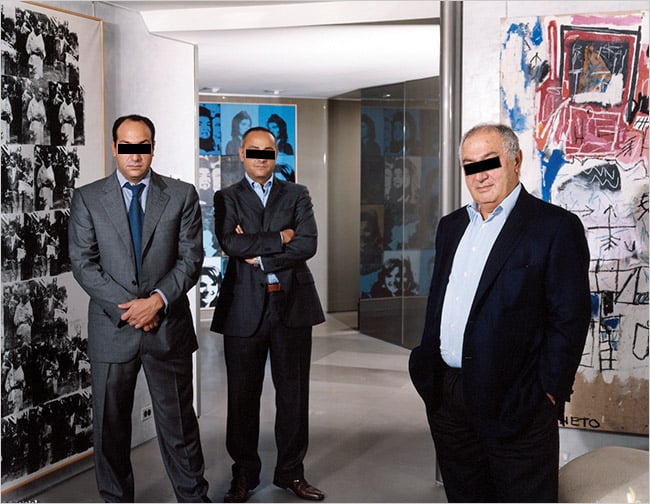
Our indomitable dealer-columnist had a busy month, to say the least.

Kenny Schachter

It doesn’t take much to get me out of the house, but what choice have I? Opportunities in the art world are scarce, and these days you need to chase them more than ever. The especially cautious economy is no time to sit still. All it took this go-round was an invitation to speak on a panel at EXPO Chicago on criticism and art writing in “the post-truth era.” I find that the art world is fine with lies—it’s the truth that market players (or quasi-participants) blanch at. That was followed by a New York stopover where I visited a fistful of galleries and the Bridge, a car show and micro art fair on a private golf course in the Hamptons.
People love to complain about art-fair overload, so get this lineup: the 20/21 British Art Fair, Contemporary Istanbul, art berlin (pretentious spelling not my own), the Code Art Fair in Copenhagen, La Biennale Paris, EXPO Chicago, and The Bridge. That would be a heavy slate in any month—and it’s only September. We are in the midst of a new (art) world order. There have been reams of press about the worrisome attrition of mid-tier galleries, seemingly dropping like flies. The notion of the traditional small-to-mid-sized gallery is fast falling by the wayside and perhaps on its way to becoming obsolete, replaced by models not yet fully articulated. I understand galleries are under pressure, but of late it’s escalated to hysteria. Tell me, when has it ever been easy to run an art gallery?
For me, 30 years in, the art business is still like crawling through mud. I lectured in the past that galleries should be federally subsidized below a certain income level if they could establish sufficient hardship—by which I mean financial hardship, not anguish over disingenuous advisors. Have dealers got a bad rap? I know an advisor formerly in the tech sector who sold buckets of art until the day he made the gaffe of referring to himself as “a dealer” in front of his friends, who had been doing all the buying previously. Hey everyone, I am no longer an art dealer (but you can call Artnet if you want to get in touch).
I don’t envy young galleries. Besides bleeding for sales, the allure of free alcohol—a common courtesy at openings—attracts a fair number of the strange and disgruntled, too. Well, misery loves company. It’s not much easier on the other side. A dealer who extricated himself from a mid-level gallery and interviewed at one of the majors was told that he wouldn’t get more than a cursory salary until he met his sales quota, which exceeded $2.5 million (at which point his share would be 10 percent of the gallery’s net profit).
I was told by a collector that Illinois was the third most populous state and that the word “Illinois” itself derives from the Chippewa word for brave. Fact-checking revealed that it’s the fifth-largest state, and means “he speaks the regular way” or “tribe of superior men.” Indeed, Chicagoans are regular in a superior sort of fashion. For one thing, there is a Midwestern mindset to show up early for work, followed by a good night’s sleep. I also observed a civic generosity of spirit in Chicago—at least when it comes to the art world—that seems quite unprecedented. An internationally prominent museum benefactor told me: “We all like each other and support each other in collecting. There’s no jealousy or competition.”
On the other hand, there is a sign at the entrance of O’Hare International Airport reminding passengers not to bring their guns with them. In 1962, Frank Sinatra gigged for a week at the Villa Venice for noted mafioso Sam Giancana (who later got a bullet to the back of the head), famously crooning in the song “Chicago (That Toddlin’ Town)”:
On State Street that great street I just want to say
They do things they don’t do on Broadway
They have a time, the time of their life
I saw a man who danced with his wife
In Chicago, Chicago my hometown
Chicago, Chicago
That toddlin’ town
Chicago also has a great collecting tradition and I was amazed by the depth of the art in the city that I hadn’t been to for 20 years. The previous iteration of the fair had been the biggest in the US until it was cannibalized by Art Basel Miami Beach in 2002. The fair formerly known as Art Chicago went from being a stalwart on the calendar to folding pitifully, only to be reborn in 2012 as EXPO Chicago (this edition being the sixth). I found it a solid undertaking in a robust region filled with a passion for art, and there was plenty of it to be admired on the walls of the great museums and private residences that I visited.
I didn’t really pay much heed to pricing or sniffing out what was and wasn’t sold—it was a more laid-back, casual atmosphere with lower price points and more experimentation by established galleries. A gallery partner who shows at the Basel fair spoke of lots of indigenous collectors and described the fair as up-and-coming; he returned after giving it a shot in 2012. He also mentioned there were not as many parties, and fewer tire-kickers. A talented local dealer, on the other hand, considered the event too expensive, with weak branding and no identity. I liked it.
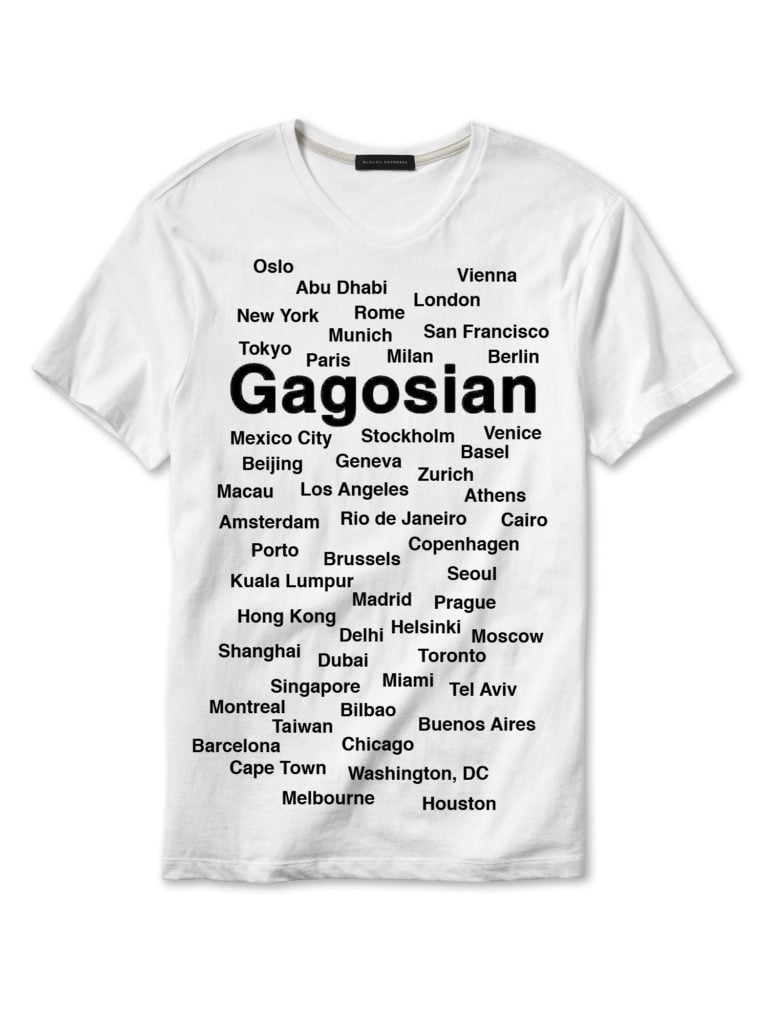
It’s a Gagosian world. Image courtesy of Kenny Schachter.
Imagine a globe with a Gagosian on every street corner—according to his booth signage, he’s nearly there. I’m in awe of Larry G., from his partnering with Leo Castelli to the dominance of his worldwide emporium. This time around he sported a Richard Prince protest painting at $650,000 (I’ve seen them for $1 million at other fairs). Richard Gray, of Chicago and New York, had a Mark Grotjahn for $1.75 million, which had been handsomely dressed in a new frame since its last fair outing. Ross Bleckner may be many moons from his market-darling moment, but his works looked great at Maruani Mercier from Brussels, priced from $60,000 to $100,000—a steal compared to what the young’uns fetch today. (Hmm, seems I did pay some attention to pricing after all.)
Designed by Renzo Piano, the Modern Wing of the Art Institute of Chicago opened in 2009 and got a boost in 2015 when Stefan Edlis and Gael Neeson donated nearly 50 great works (valued at nearly half a billion), from showstoppers by Jasper Johns and Warhol to a cache of interesting works made since. No vanity private museum, this was instead a charitable gesture that benefitted the city—an exemplary act. I also admire gallerist and art teacher Shane Campbell, a sweetheart with a rigorous program to boot, whose South Loop gallery featured a formidable installation by local talent Tony Lewis consisting of a mountainous cascade of graphite-laden paper nearly reaching the ceiling.
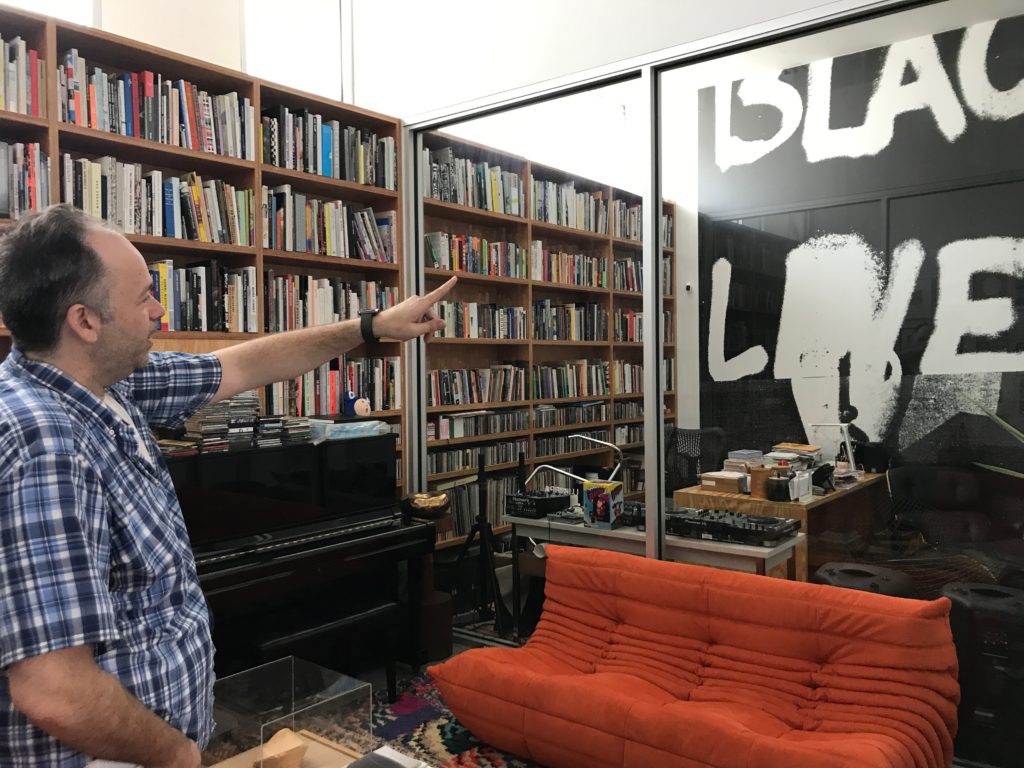
Dealer Shane Campbell with an Adam Pendleton in his office. Image courtesy of Kenny Schachter.
Corbett vs. Dempsey (the names of the two dealers behind the gallery, and also two famous boxers who never fought, hence the “vs.”) hosted “Small Sculpture,” a tabletop show bursting with covetable, intimately scaled objects. When I tried to buy a Rachel Harrison and asked for a courtesy discount as tiny as the works on display, I was shot down—even though I’ve worked with the artist for 27 years. Charming.
The art market is a little like Trump, and not just because its largely made up of his supporters. Much like the president, top collectors don’t want to disclose their taxes or anything else for that matter, including the machinations of the market. In a sense, there’s fake news everywhere. You’ve always needed common sense and healthy dose of criticality—hyperbole, after all, is human nature, as is the propensity to present things (or oneself) as better than their reality. Ask anyone at a fair how the art is selling and you will hear much of the same. I, for one, admit to once telling Bloomberg News I had sold out when I hadn’t sold a single, sad, solitary piece.
In my panel presentation at EXPO, in order to illustrate auction shenanigans, I projected an image of one well-known dealing dynasty, with obscured eyes to protect their identities. I also recounted an instance where a high visibility lot in a ubiquitous charity auction was the subject of a guarantee, a practice that’s never been publicly disclosed. In another slide, I reproduced the now widely seen and much-commented-upon Mark Grotjahn Instagram post that said: “Yo Phillips. (. Dm. Me.). I’m not sure I made this. Either way it sucks.” It reads like a concrete poem, but it incited an avalanche of chatter, and forced Phillips to remove the now-aspersed work from an upcoming auction.
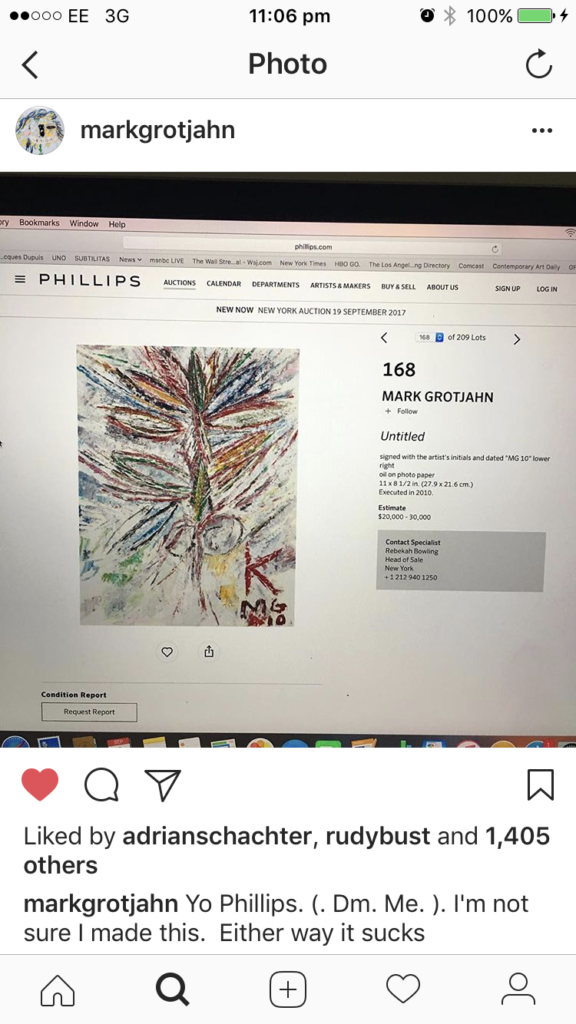
Mark Grotjahn’s Instagram. Image courtesy of Kenny Schachter.
Here is the rub: on the undisputedly Mark Grotjahn-made artwork there is the letter ‘K’ painted in glowing red. ‘K’ is for Kimberly, as in Kimberly Chang, art advisor to Cirque du Soleil founder Guy Laliberté. I guess Mark wasn’t amused by the deaccession. Speaking of deaccessions, I also heard from Deep Pockets—now returned from a summer of island-hopping—that Leo DiCaprio and his advisor Lisa Schiff have parted ways, although she’s working out her contract term. Leo’s frequent selling activities are known by many and understood by few. I should start an art-advisor advisory business.
Arriving smack in the middle of the 72nd session of the UN General Assembly meetings, I found myself squeezed for a reasonable hotel room. A friend kindly mentioned the discounted rates at the Trump International Hotel and Tower, otherwise known as One Central Park West (to me anyway), which is where I would tell people I was staying. (Don’t tell Jerry Saltz, please). Due to the creepy, weird vibe, I practically had to serpentine in from the sidewalk with my chin tucked down. A decrepit, moldy-smelling room it was, but damn cheaper than many others. Wonder why. The views were great but the downside was Trump-branded everything: wine, mouthwash, soap, matches. My blood pressure spiked every time I entered my room. Good thing I’m not on American healthcare.
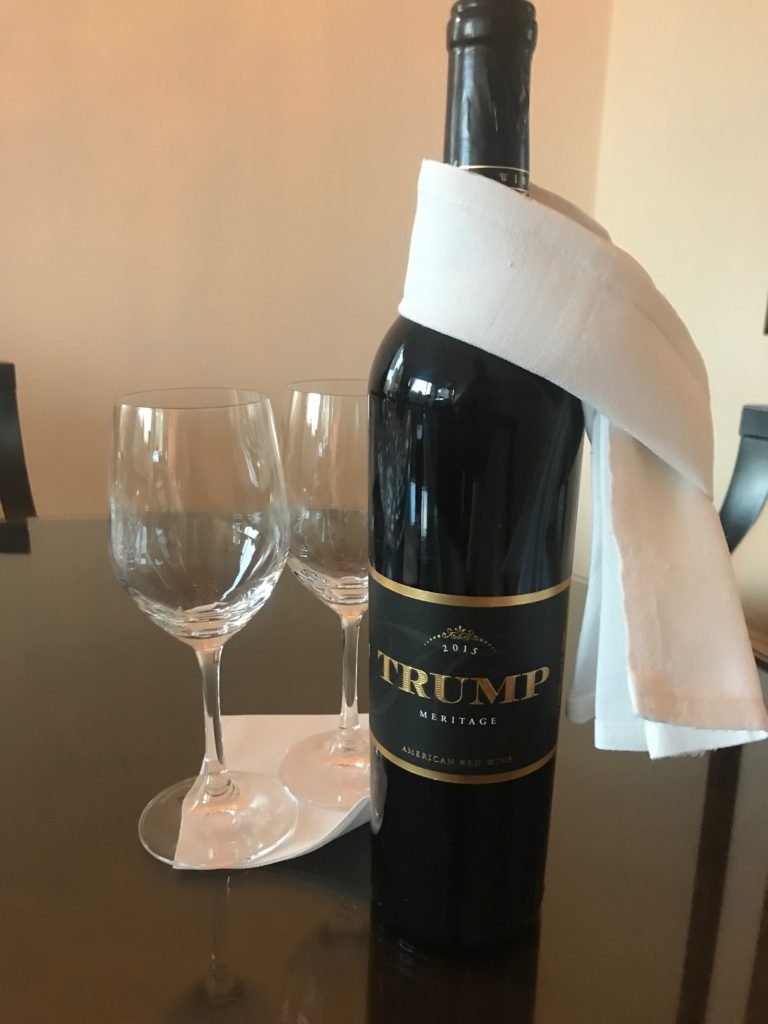
Cheers, Jerry! Image courtesy of Kenny Schachter.
Then, not more than an hour after arriving (and immediately seeing someone getting arrested at LaGuardia), a cop car swooped in as I spoke to my wife while sipping a beer on the sidewalk in front of Brooklyn’s Clearing Gallery. Despite my repeated protestations that drinking in the streets is perfectly legal where I come from (it is), the officer took my license and went on to deliberate for nearly 30 minutes inside the vehicle with his partner on the beat before finally issuing me a ticket for public drinking. The give-and-take convo must have been a real-life good cop/bad cop moment. I was going to make another kind of negotiation, maybe a $10 or $15 bribe in cold hard cash (just to be annoying, as I am wont to do), as opposed to the $25 fine. We know how badly that could have ended… cops these days! They might consider enforcing the penalty with community service at Phillips.
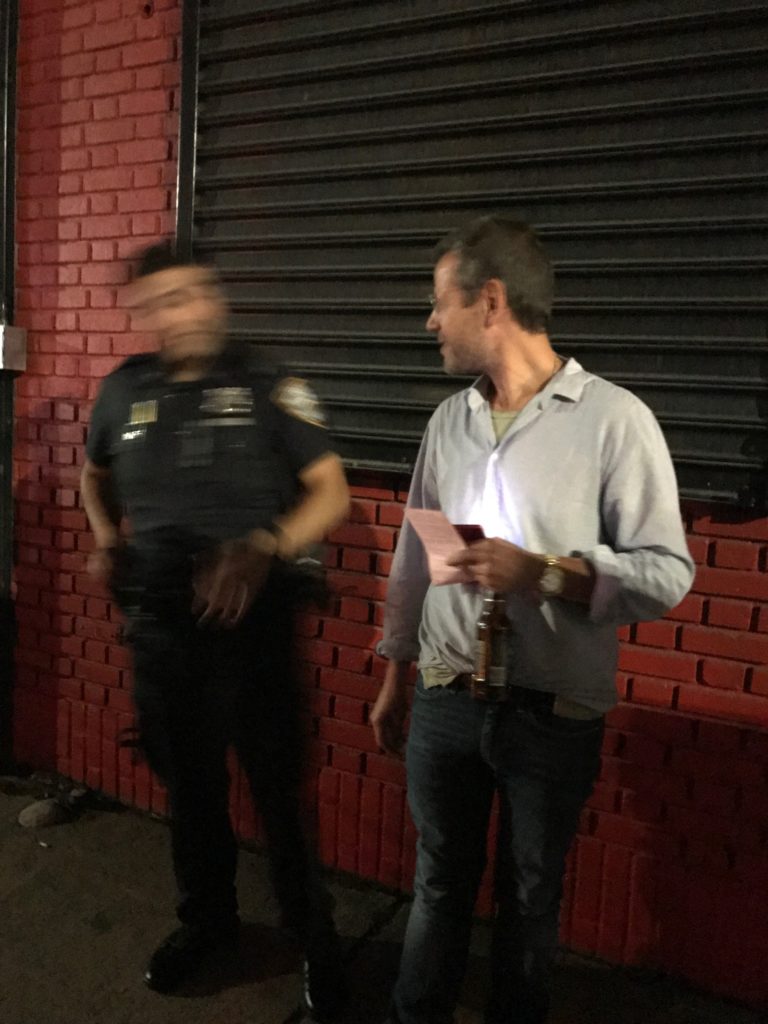
To bribe or not to bribe? Image courtesy of Kenny Schachter.
Maxwell Graham, trenchant conceptual warrior and proprietor of Essex Street Gallery on the Lower East Side, was a student of Shane Campbell back in Chicago. When I paid a visit, Max offered up his entire gallery for sale to the young dealer I showed up with. He then introduced me to the work of sculptor/installation artist Cameron Rowland, who considers issues of subjugation and abuse in the workplace. Sometimes you can buy the work, other occasions you must rent it—the sales agreement is part and parcel of the art. The new waiting list, these days, is for young art in commercial galleries that is not for sale.
The Bridge, a six-gallery art fair in the Hamptons in the middle of September, goes a long way to prove that I am not alone wanting to spend most of my waking hours looking at, thinking about, talking about, and working in art. Call it Process Addiction, which is the physiological, chemical necessity for incessant sex, eating, gambling, shopping, and in my case, arting. I find it a healthy and satisfying obsession. And with my limited attention span, six galleries actually seems an ideal quota of galleries for a given fair—Basel, take note! Though I suspect, from the initial success of this cozy event, next year’s edition of the Bridge will grow, like the fake weeds crafted by sculptor Tony Matelli at the booth of Marlborough Contemporary, a founder of the event.
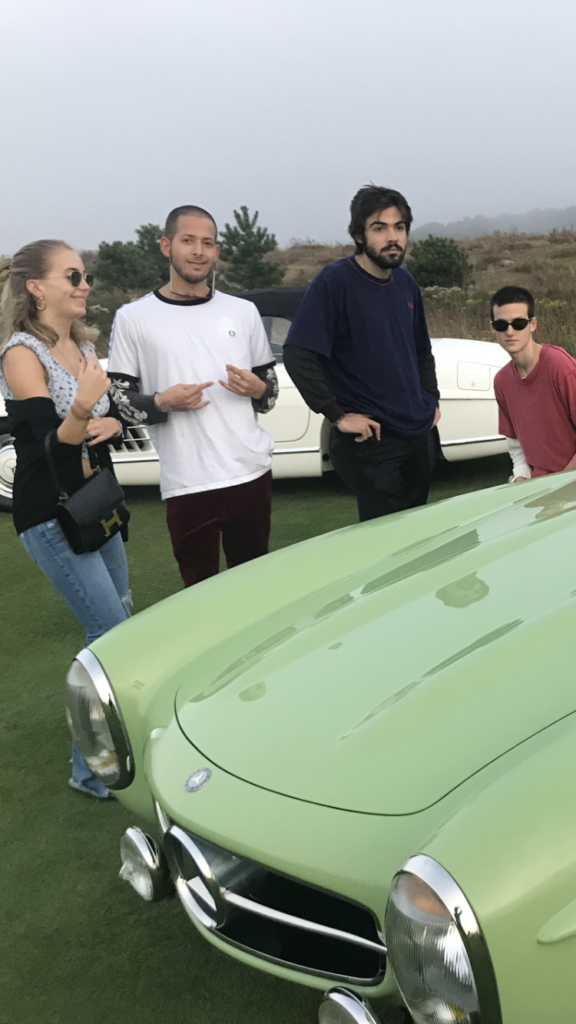
Caroline Hoffman, Adrian Schachter, Caio Twombly, and Kai Schachter with a Mercedes 300SL at the Bridge fair. Image courtesy of Kenny Schachter.
This was a ritzy shindig, but a nice experience for those that could make it: the commingling of art and classic cars. Paddy Johnson of Art F City has criticized the “casual privilege” evidenced by my writings and I agree she’s got a point. I’m glad she wasn’t in Bridgehampton last week. Not to dodge the implications, but it is what it is, and always has been. He or she who had the most shells, sticks, or rocks (or the equivalent) bought the first off-the-cave art, and probably flipped it shortly thereafter to another caveman/woman for the wampum of the day.
I also visited gallerist/artist (today’s actor/bartender) Joel Mesler of Rental Gallery, who will host a retrospective of the artworks I’ve created for my artnet columns (and for over 30 years before) next summer in East Hampton. And, in an extreme act of onanistic nepotism, Joel will display his own paintings in Miami at the next version of NADA. He calls himself the young me (since he writes, deals, and makes art) and frequently refers to himself as unsuccessful despite vast efforts. I consider myself lucky to have my art-world DNA in such fine hands.
Back in London, on way to pick up a newspaper (with which I still engage in the physical world, call me old-fashioned), I stumbled across a pop-up exhibition just down the street from my house called “Old and Young.” The space was being invigilated by 18-year-old Sebastian Mahal, an artist with work in the show, along with a collective called, fitting enough, Fiasco. Turns out Seb’s dad is a Fiasco member, and an “ex-hedge fund and investment banker now launching a new start up in the co-working sector.” Making art about the ruthless, omnivorous financial sector—how could you not love the hypocrisy? But it evinces a never-ending stream of endeavors to present works of all stripes on a street corner near you (unless Gagosian gets there first).
The art world is my favorite world, and though I have overall macroeconomic concerns—especially in London—I am anticipating a massively strong fall. What could prove to be emblematic of a still surging art market is the fact that Loic Gouzer of Christie’s is on the verge of announcing a blockbuster addition to the November New York sales that will be valued in excess of $100 million. That’s a lot of clamshells. I doubt whatever it is won’t sell, and sell well.